Analysis of Project Brief in Construction Management Course
VerifiedAdded on 2021/05/31
|7
|1149
|125
Report
AI Summary
This report focuses on the project brief in construction management, detailing its evolution, preparation, and inclusions. It begins with an introduction explaining the importance of briefing in conveying client needs to construction companies. The report then explores the project brief phase, including the preparation process guided by consultants and the collection of relevant data. It emphasizes the importance of substantiating objectives, aligning expenditure with client expectations, and considering factors like site surveys and stakeholder consultations. The report further outlines the inclusions of a project brief, such as client culture, company vision, and spatial and technical requirements. It covers various aspects like structural approaches, servicing necessities, and sustainability aims. Finally, it discusses project prerequisites, program planning, and the potential for database presentations. The project brief is demonstrated as a critical document in the construction industry, ensuring presentable, achievable, and client-satisfying work.
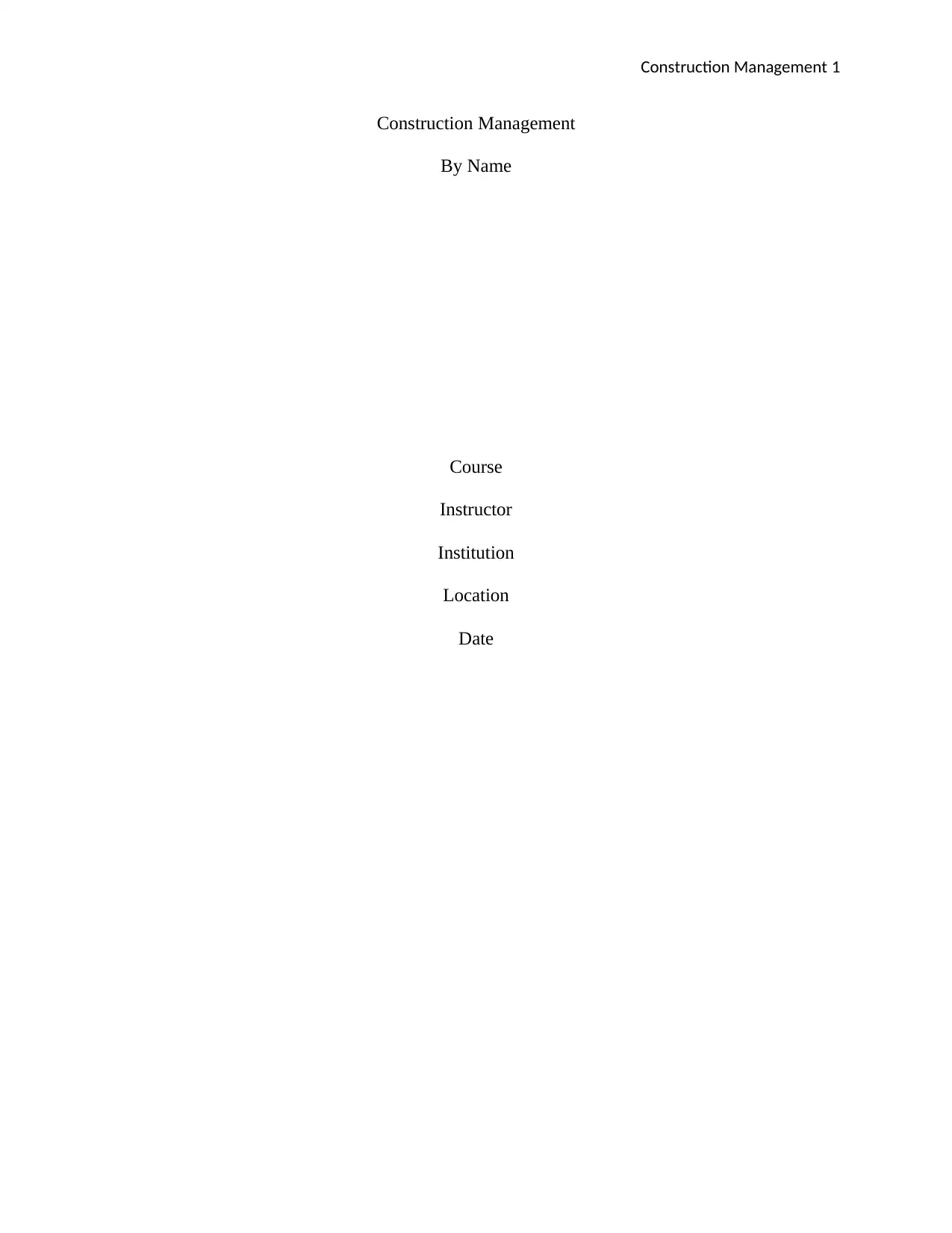
Construction Management 1
Construction Management
By Name
Course
Instructor
Institution
Location
Date
Construction Management
By Name
Course
Instructor
Institution
Location
Date
Paraphrase This Document
Need a fresh take? Get an instant paraphrase of this document with our AI Paraphraser
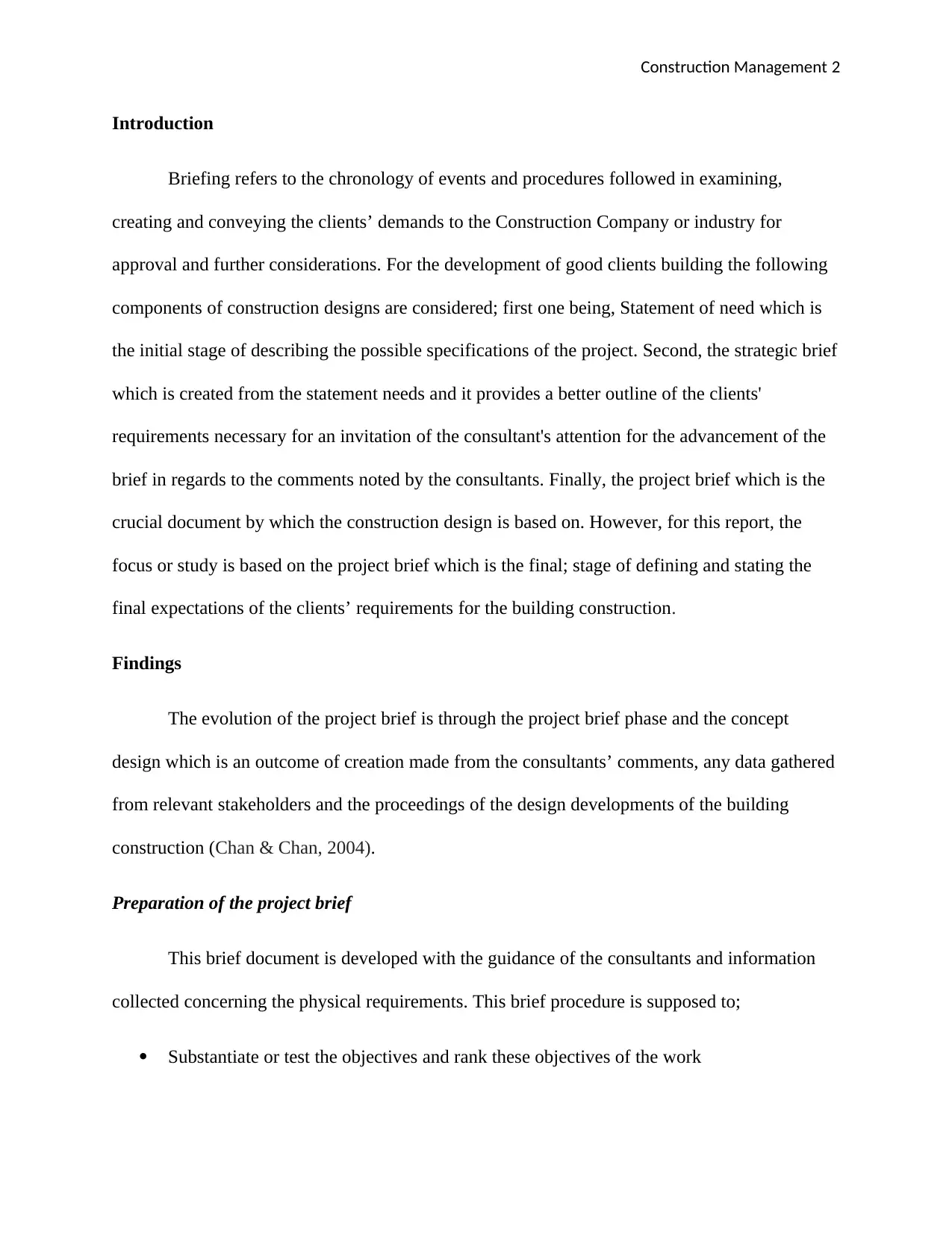
Construction Management 2
Introduction
Briefing refers to the chronology of events and procedures followed in examining,
creating and conveying the clients’ demands to the Construction Company or industry for
approval and further considerations. For the development of good clients building the following
components of construction designs are considered; first one being, Statement of need which is
the initial stage of describing the possible specifications of the project. Second, the strategic brief
which is created from the statement needs and it provides a better outline of the clients'
requirements necessary for an invitation of the consultant's attention for the advancement of the
brief in regards to the comments noted by the consultants. Finally, the project brief which is the
crucial document by which the construction design is based on. However, for this report, the
focus or study is based on the project brief which is the final; stage of defining and stating the
final expectations of the clients’ requirements for the building construction.
Findings
The evolution of the project brief is through the project brief phase and the concept
design which is an outcome of creation made from the consultants’ comments, any data gathered
from relevant stakeholders and the proceedings of the design developments of the building
construction (Chan & Chan, 2004).
Preparation of the project brief
This brief document is developed with the guidance of the consultants and information
collected concerning the physical requirements. This brief procedure is supposed to;
Substantiate or test the objectives and rank these objectives of the work
Introduction
Briefing refers to the chronology of events and procedures followed in examining,
creating and conveying the clients’ demands to the Construction Company or industry for
approval and further considerations. For the development of good clients building the following
components of construction designs are considered; first one being, Statement of need which is
the initial stage of describing the possible specifications of the project. Second, the strategic brief
which is created from the statement needs and it provides a better outline of the clients'
requirements necessary for an invitation of the consultant's attention for the advancement of the
brief in regards to the comments noted by the consultants. Finally, the project brief which is the
crucial document by which the construction design is based on. However, for this report, the
focus or study is based on the project brief which is the final; stage of defining and stating the
final expectations of the clients’ requirements for the building construction.
Findings
The evolution of the project brief is through the project brief phase and the concept
design which is an outcome of creation made from the consultants’ comments, any data gathered
from relevant stakeholders and the proceedings of the design developments of the building
construction (Chan & Chan, 2004).
Preparation of the project brief
This brief document is developed with the guidance of the consultants and information
collected concerning the physical requirements. This brief procedure is supposed to;
Substantiate or test the objectives and rank these objectives of the work
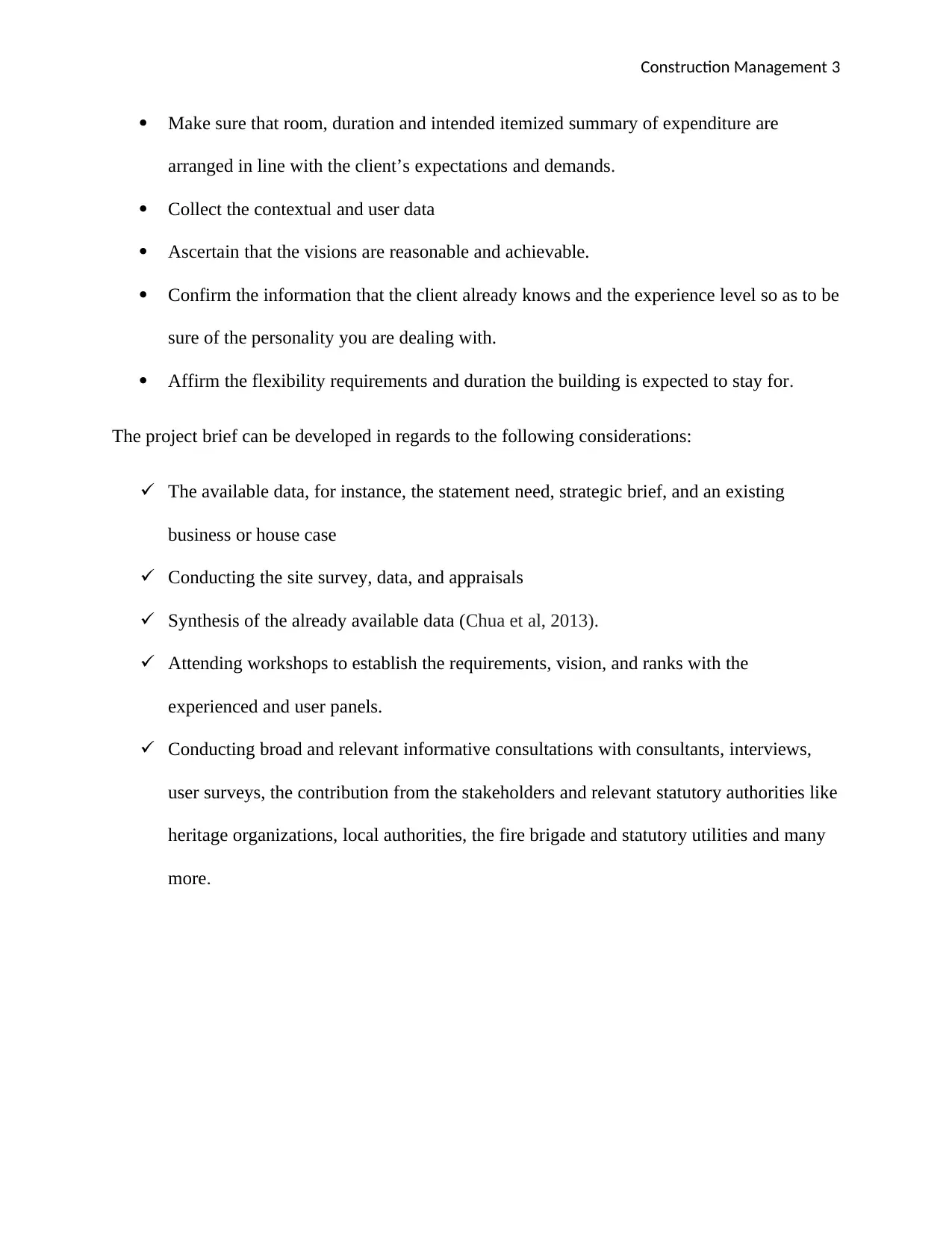
Construction Management 3
Make sure that room, duration and intended itemized summary of expenditure are
arranged in line with the client’s expectations and demands.
Collect the contextual and user data
Ascertain that the visions are reasonable and achievable.
Confirm the information that the client already knows and the experience level so as to be
sure of the personality you are dealing with.
Affirm the flexibility requirements and duration the building is expected to stay for.
The project brief can be developed in regards to the following considerations:
The available data, for instance, the statement need, strategic brief, and an existing
business or house case
Conducting the site survey, data, and appraisals
Synthesis of the already available data (Chua et al, 2013).
Attending workshops to establish the requirements, vision, and ranks with the
experienced and user panels.
Conducting broad and relevant informative consultations with consultants, interviews,
user surveys, the contribution from the stakeholders and relevant statutory authorities like
heritage organizations, local authorities, the fire brigade and statutory utilities and many
more.
Make sure that room, duration and intended itemized summary of expenditure are
arranged in line with the client’s expectations and demands.
Collect the contextual and user data
Ascertain that the visions are reasonable and achievable.
Confirm the information that the client already knows and the experience level so as to be
sure of the personality you are dealing with.
Affirm the flexibility requirements and duration the building is expected to stay for.
The project brief can be developed in regards to the following considerations:
The available data, for instance, the statement need, strategic brief, and an existing
business or house case
Conducting the site survey, data, and appraisals
Synthesis of the already available data (Chua et al, 2013).
Attending workshops to establish the requirements, vision, and ranks with the
experienced and user panels.
Conducting broad and relevant informative consultations with consultants, interviews,
user surveys, the contribution from the stakeholders and relevant statutory authorities like
heritage organizations, local authorities, the fire brigade and statutory utilities and many
more.
⊘ This is a preview!⊘
Do you want full access?
Subscribe today to unlock all pages.

Trusted by 1+ million students worldwide
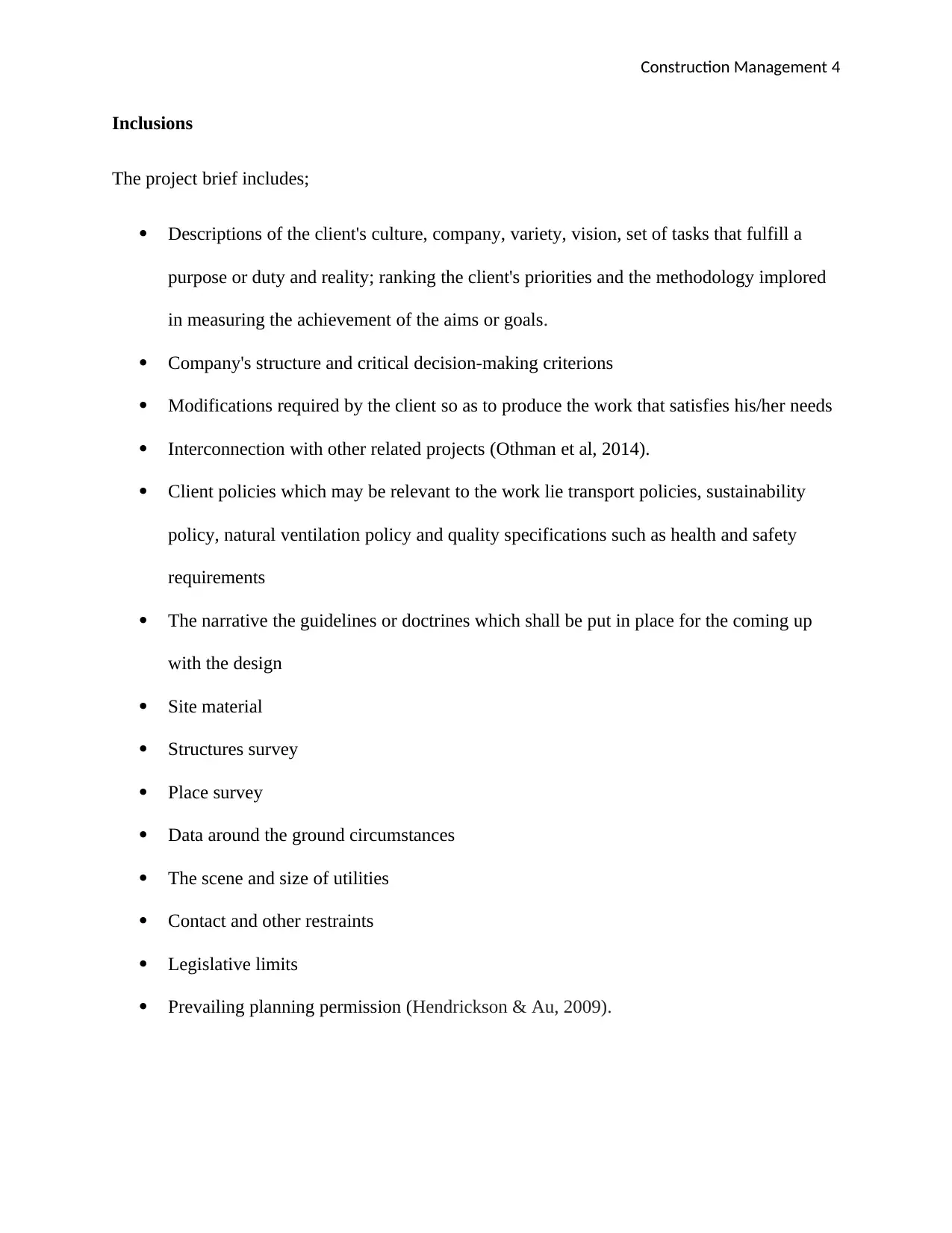
Construction Management 4
Inclusions
The project brief includes;
Descriptions of the client's culture, company, variety, vision, set of tasks that fulfill a
purpose or duty and reality; ranking the client's priorities and the methodology implored
in measuring the achievement of the aims or goals.
Company's structure and critical decision-making criterions
Modifications required by the client so as to produce the work that satisfies his/her needs
Interconnection with other related projects (Othman et al, 2014).
Client policies which may be relevant to the work lie transport policies, sustainability
policy, natural ventilation policy and quality specifications such as health and safety
requirements
The narrative the guidelines or doctrines which shall be put in place for the coming up
with the design
Site material
Structures survey
Place survey
Data around the ground circumstances
The scene and size of utilities
Contact and other restraints
Legislative limits
Prevailing planning permission (Hendrickson & Au, 2009).
Inclusions
The project brief includes;
Descriptions of the client's culture, company, variety, vision, set of tasks that fulfill a
purpose or duty and reality; ranking the client's priorities and the methodology implored
in measuring the achievement of the aims or goals.
Company's structure and critical decision-making criterions
Modifications required by the client so as to produce the work that satisfies his/her needs
Interconnection with other related projects (Othman et al, 2014).
Client policies which may be relevant to the work lie transport policies, sustainability
policy, natural ventilation policy and quality specifications such as health and safety
requirements
The narrative the guidelines or doctrines which shall be put in place for the coming up
with the design
Site material
Structures survey
Place survey
Data around the ground circumstances
The scene and size of utilities
Contact and other restraints
Legislative limits
Prevailing planning permission (Hendrickson & Au, 2009).
Paraphrase This Document
Need a fresh take? Get an instant paraphrase of this document with our AI Paraphraser
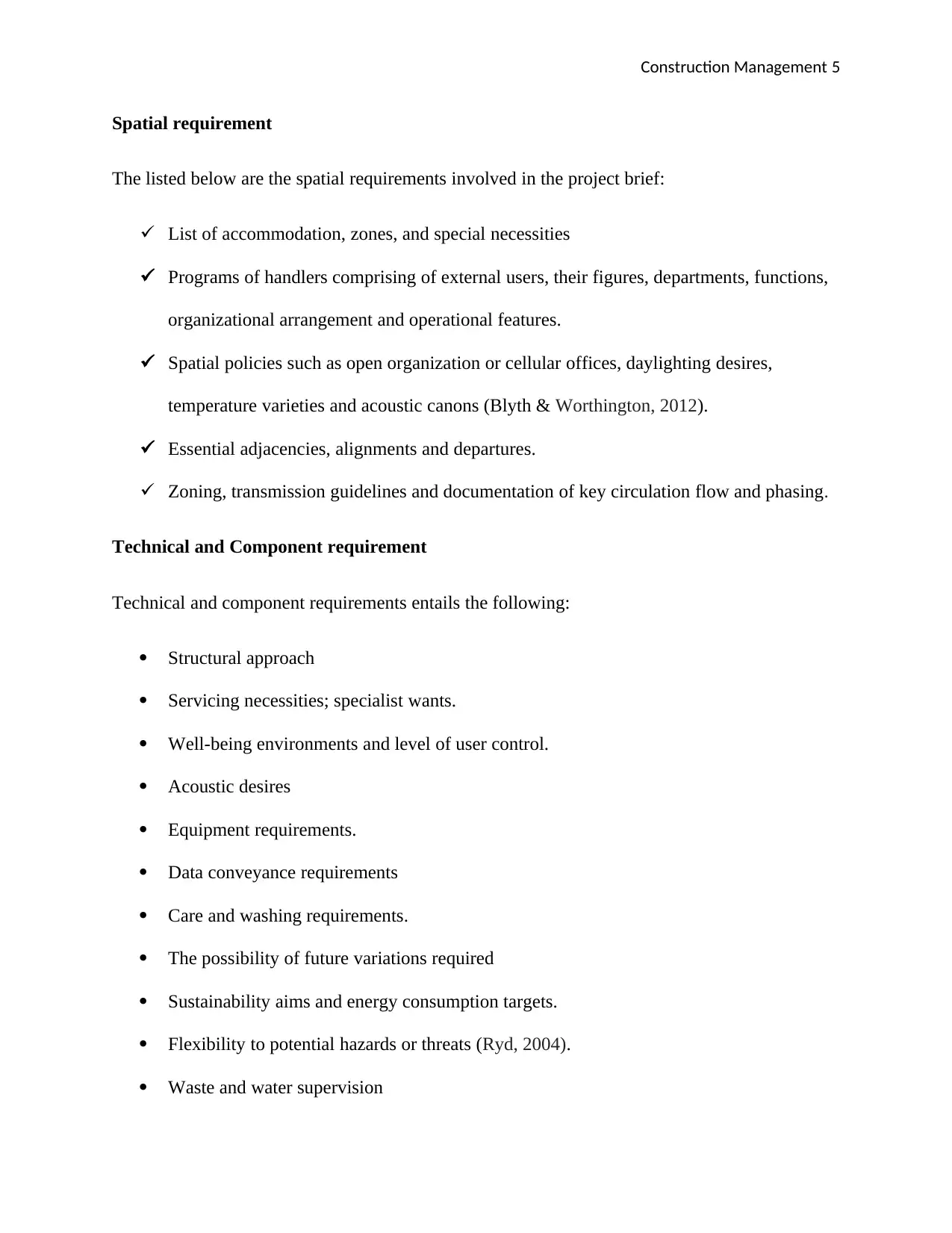
Construction Management 5
Spatial requirement
The listed below are the spatial requirements involved in the project brief:
List of accommodation, zones, and special necessities
Programs of handlers comprising of external users, their figures, departments, functions,
organizational arrangement and operational features.
Spatial policies such as open organization or cellular offices, daylighting desires,
temperature varieties and acoustic canons (Blyth & Worthington, 2012).
Essential adjacencies, alignments and departures.
Zoning, transmission guidelines and documentation of key circulation flow and phasing.
Technical and Component requirement
Technical and component requirements entails the following:
Structural approach
Servicing necessities; specialist wants.
Well-being environments and level of user control.
Acoustic desires
Equipment requirements.
Data conveyance requirements
Care and washing requirements.
The possibility of future variations required
Sustainability aims and energy consumption targets.
Flexibility to potential hazards or threats (Ryd, 2004).
Waste and water supervision
Spatial requirement
The listed below are the spatial requirements involved in the project brief:
List of accommodation, zones, and special necessities
Programs of handlers comprising of external users, their figures, departments, functions,
organizational arrangement and operational features.
Spatial policies such as open organization or cellular offices, daylighting desires,
temperature varieties and acoustic canons (Blyth & Worthington, 2012).
Essential adjacencies, alignments and departures.
Zoning, transmission guidelines and documentation of key circulation flow and phasing.
Technical and Component requirement
Technical and component requirements entails the following:
Structural approach
Servicing necessities; specialist wants.
Well-being environments and level of user control.
Acoustic desires
Equipment requirements.
Data conveyance requirements
Care and washing requirements.
The possibility of future variations required
Sustainability aims and energy consumption targets.
Flexibility to potential hazards or threats (Ryd, 2004).
Waste and water supervision
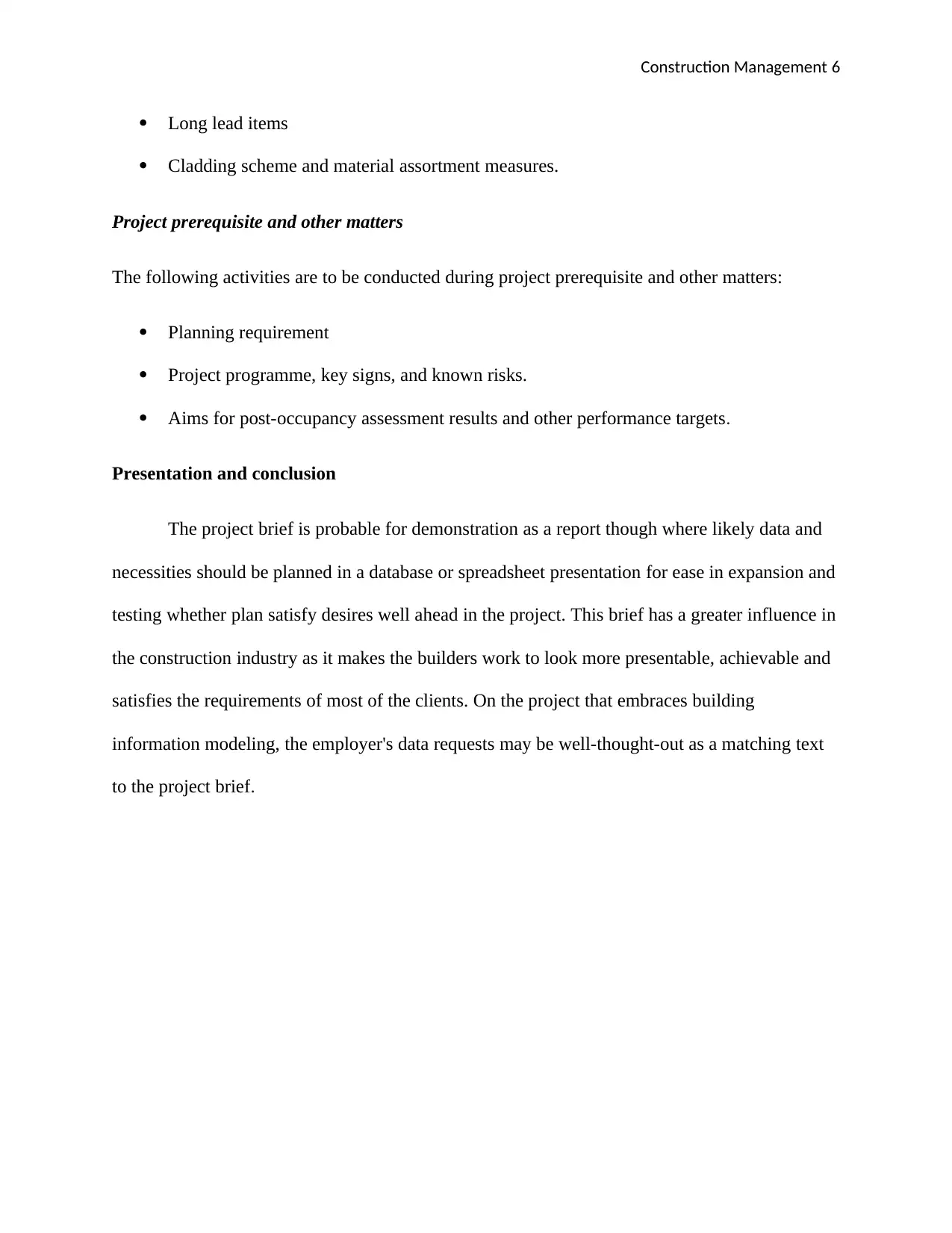
Construction Management 6
Long lead items
Cladding scheme and material assortment measures.
Project prerequisite and other matters
The following activities are to be conducted during project prerequisite and other matters:
Planning requirement
Project programme, key signs, and known risks.
Aims for post-occupancy assessment results and other performance targets.
Presentation and conclusion
The project brief is probable for demonstration as a report though where likely data and
necessities should be planned in a database or spreadsheet presentation for ease in expansion and
testing whether plan satisfy desires well ahead in the project. This brief has a greater influence in
the construction industry as it makes the builders work to look more presentable, achievable and
satisfies the requirements of most of the clients. On the project that embraces building
information modeling, the employer's data requests may be well-thought-out as a matching text
to the project brief.
Long lead items
Cladding scheme and material assortment measures.
Project prerequisite and other matters
The following activities are to be conducted during project prerequisite and other matters:
Planning requirement
Project programme, key signs, and known risks.
Aims for post-occupancy assessment results and other performance targets.
Presentation and conclusion
The project brief is probable for demonstration as a report though where likely data and
necessities should be planned in a database or spreadsheet presentation for ease in expansion and
testing whether plan satisfy desires well ahead in the project. This brief has a greater influence in
the construction industry as it makes the builders work to look more presentable, achievable and
satisfies the requirements of most of the clients. On the project that embraces building
information modeling, the employer's data requests may be well-thought-out as a matching text
to the project brief.
⊘ This is a preview!⊘
Do you want full access?
Subscribe today to unlock all pages.

Trusted by 1+ million students worldwide
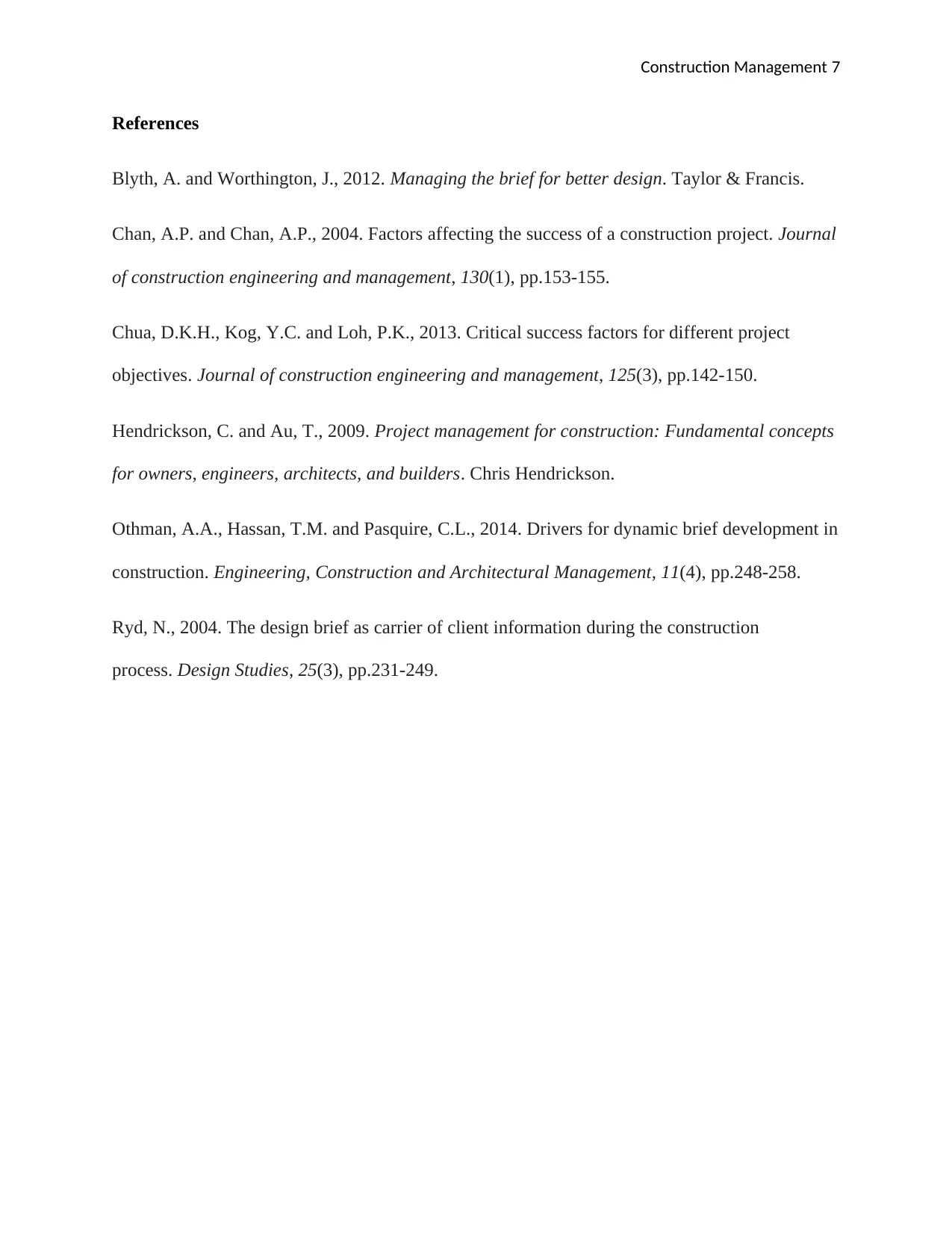
Construction Management 7
References
Blyth, A. and Worthington, J., 2012. Managing the brief for better design. Taylor & Francis.
Chan, A.P. and Chan, A.P., 2004. Factors affecting the success of a construction project. Journal
of construction engineering and management, 130(1), pp.153-155.
Chua, D.K.H., Kog, Y.C. and Loh, P.K., 2013. Critical success factors for different project
objectives. Journal of construction engineering and management, 125(3), pp.142-150.
Hendrickson, C. and Au, T., 2009. Project management for construction: Fundamental concepts
for owners, engineers, architects, and builders. Chris Hendrickson.
Othman, A.A., Hassan, T.M. and Pasquire, C.L., 2014. Drivers for dynamic brief development in
construction. Engineering, Construction and Architectural Management, 11(4), pp.248-258.
Ryd, N., 2004. The design brief as carrier of client information during the construction
process. Design Studies, 25(3), pp.231-249.
References
Blyth, A. and Worthington, J., 2012. Managing the brief for better design. Taylor & Francis.
Chan, A.P. and Chan, A.P., 2004. Factors affecting the success of a construction project. Journal
of construction engineering and management, 130(1), pp.153-155.
Chua, D.K.H., Kog, Y.C. and Loh, P.K., 2013. Critical success factors for different project
objectives. Journal of construction engineering and management, 125(3), pp.142-150.
Hendrickson, C. and Au, T., 2009. Project management for construction: Fundamental concepts
for owners, engineers, architects, and builders. Chris Hendrickson.
Othman, A.A., Hassan, T.M. and Pasquire, C.L., 2014. Drivers for dynamic brief development in
construction. Engineering, Construction and Architectural Management, 11(4), pp.248-258.
Ryd, N., 2004. The design brief as carrier of client information during the construction
process. Design Studies, 25(3), pp.231-249.
1 out of 7
Related Documents
Your All-in-One AI-Powered Toolkit for Academic Success.
+13062052269
info@desklib.com
Available 24*7 on WhatsApp / Email
![[object Object]](/_next/static/media/star-bottom.7253800d.svg)
Unlock your academic potential
Copyright © 2020–2025 A2Z Services. All Rights Reserved. Developed and managed by ZUCOL.





